Posts Tagged ‘coin value’
How much is your A-Z 10p worth now? August 2020 Update!
The A-Z of Great Britain 10p coins have been a firm favourite with collectors since they were first released in 2018, with 26 Quintessentially British designs capturing the public’s imagination.
Unsurprisingly, some designs are proving more popular than others, but which ones are likely to fetch the most on the secondary market?
We’ve done the hard work for you by taking a look at which A-Z 10p coins are selling for the most on eBay and which ones you should be looking out for.

The Ones to Watch…
If you’re lucky enough to have the ‘A’ for Angel of the North 10p in your collection, you might want to keep hold of it as it currently sells for around £4.20 on the secondary market – over 40 times its face value!
Despite dropping down our August A-Z 10p Scarcity Index, now sitting at the lower half of the index, the ‘B’ for Bond 10p could still fetch you around £3.90!
The N for ‘NHS’ 10p has also increased in value on the secondary market, which comes as no surprise as it also climbed to top spot on our Scarcity Index in May. In recent months, perhaps more than ever, the NHS has played a vital role in keeping us safe and this 10p acts as a reminder of the strength, hope and support of our National Health Service.
How Many A-Z 10ps Are Out There?
In 2019 it was confirmed that there were only 220,000 of each individual design released into circulation in 2018. We know that there were 2.1 million coins issued for 2019 but we’re yet to find out the individual mintage figures for each design.
When the official figures are released we could well see some of these coins increasing in value on the secondary market due to their low mintage!
These coins are notoriously tricky to find, but have you been lucky enough to come across any in your change? Let us know in the comments below.
Own the 2019 Complete Certified Uncirculated A-Z 10p Set

To secure the 2019 Complete Certified Uncirculated A-Z 10p Set, click here
20 Surprising Facts About UK Coins…
Do you think you have a good knowledge of UK coinage? Well check out these 20 surprising facts that you might not know about UK coins!
1. The direction of each monarch’s effigy faces in the opposite direction to their immediate predecessor. This has been tradition since the time of Charles II onwards, with the only exception being Edward VIII, as he preferred his left portrait to his right, which was the side proposed for coins of his reign.

2. Two 1p coins weigh the same as one 2p coin, and two 5p coins weigh the same as one 10p coin. A 1p coin weighs 3.56g, so times that by 2 and you’ve got the weight of a 2 pence piece, 7.12g

3. Whilst the high-value banknote in general circulation is the £50 note, there are such things as £1 million notes and £100 million notes. They are locked away deep in the Bank of England’s vaults and are used to back the value of every notes issued by commercial banks in Scotland and Northern Ireland.

4. The word Farthing derived from a shortening of the word ‘Fourthing’. As far back as 1060, an English coin was shaped like a clover, so that any of the four leaves could be broken off and used as separate pieces of currency.
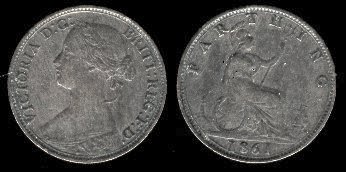
5. The commonly used term ‘quid’ actually originates from the phrase Quid Pro Quo, which translates literally to ‘what for what’. This term first appeared back in 1661!
6. According to the central banks, Brits are the world leaders at counterfeiting. There are an estimated 300 fake notes in every one million sterling notes!
7. When the UK prepared for the decimalization of its coinage, the government embarked on an enormous media campaign including leaflets, TV spots and even songs!
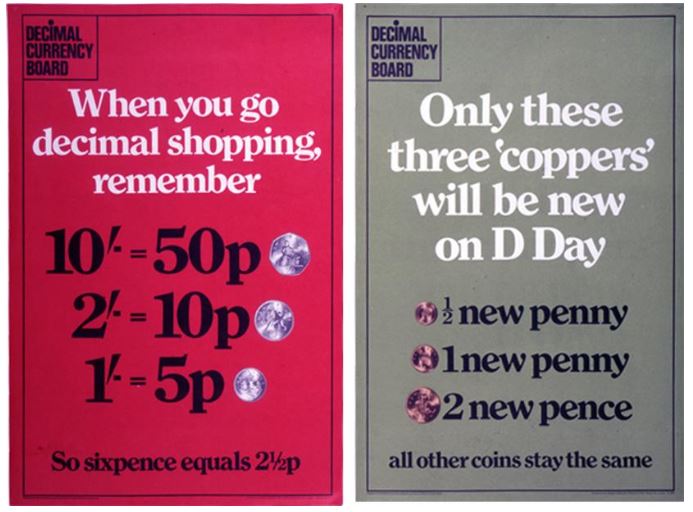
8. During the Second World War, Nazi Germany produced huge quantities of counterfeit sterling notes to try and devalue British currency. By 1945 a huge 12% of the notes in existence were counterfeit! The problem was solved by removing higher denomination notes from circulation and putting metal threads through new notes, making them harder to forge.
9. Stamps are not legal tender. Whilst you are free to accept stamps as payment for a service or goods, there is no legal obligation for you to accept them when offered. They have however been used as emergency currency in other countries.

10. You cannot pay fines in pennies. Have you ever considered paying a parking fine you didn’t think was fair with nothing but pennies? Well, be aware that the council is under no obligation to accept them! While relevant parties can choose to accept any type of payment they wish, in England and Wales restrictions apply on sums below £1.
11. Despite common belief, the polymer notes are not indestructible. Although we don’t recommend destroying them as you won’t be able to spend them!
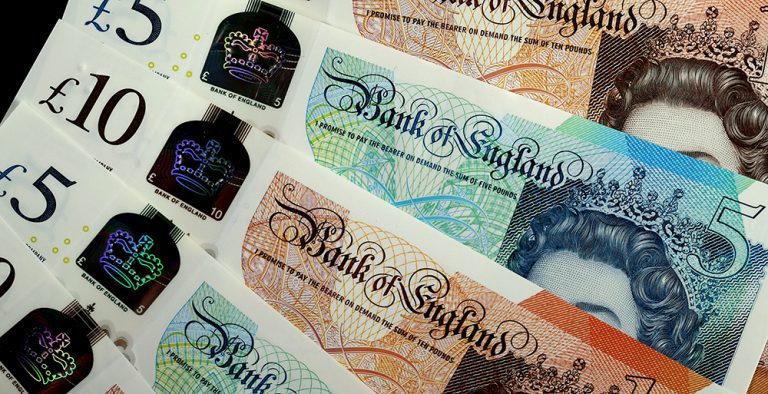
12. An estimated 28,850,000,000 UK coins are in circulation today! This is equivalent to almost 4 billion pounds worth of coins!
13. The use of gold in UK coinage ended when the First World War began. The gold sovereign, prior to 1914, was worth about £1 in circulation. However, the public were asked to hand any in to help fund the war effort. In its place came the £1 and £10 notes.
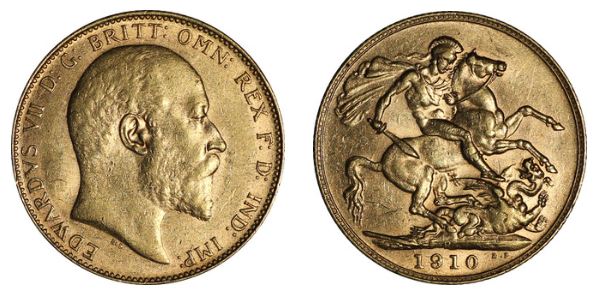
14. There is a myriad of Cockney rhyming slang to describe money. Apple core means £20, Uncle Ben means 10 and if someone asks to borrow a taxi driver, they actually mean a fiver.
15. The ‘coppers’ in your change, aren’t actually made of copper. Since 1992, 1p and 2p coins have been made of steel, with a copper plating.

16. The UK’s current definitive coinage dated 2008 or younger, make up the design of the Shield of the Royal Arms when they are all placed together. Pretty cool, right?

17. Legend has it, the M11 has an exit but not an entry at Junction 5 to prevent would-be thieves escaping. This is because of its close proximity to the De La Rue Currency factory – where banknotes are printed for the Bank of England. This way, any potential robbers wouldn’t be able to make their escape quickly out of London and onto a motorway.
18. The Queen must officially approve any coin design before it can be made. The design is first put to the Chancellor, who then passes it on to the Queen for her official sign-off.
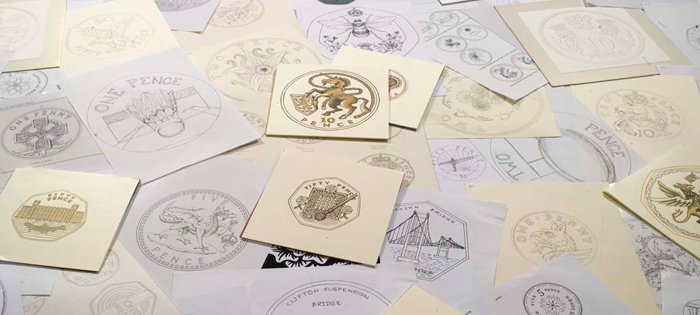
19. A full judicial trial is held to test newly-minted coins – called the Trial of the Pyx. This ceremony is held to ensure newly-minted coins conform to the required standards. The trials are held once a year and the coin’s diameter, chemical composition and weight is tested. These trials have been held since the 12th century and the process remains largely unchanged since that date!

20. If you find a buried treasure chest of money and don’t report it, you could face a prison sentence! Technically any hidden treasure found in the UK belongs to the Queen! All findings must be reported to the coroner within 14 days and the treasure will be offered to museums. If the museums choose not to bid on it, then the finder/land-owner gets to receive it.
How many of these surprising facts did you already know? Let us know in the comments below!
If you’re interested in coin collecting, our Change Checker web app is completely free to use and allows users to:
– Find and identify the coins in their pocket
– Collect and track the coins they have
– Swap their spare coins with other Change Checkers

Sign up today at: www.changechecker.org/app
How much is my coin worth? June 2019 eBay Tracker update!
We’re excited to present your latest eBay Tracker and Valuation Index for the Top 10 UK coins and banknotes!
The secondary market can be a bit of a minefield, but if you’ve found a rare coin or banknote and want to work out how much it might be worth, we’ve done the hard work for you…
eBay Tracker
Find out which coins and notes have been the key movers and shakers in the updated eBay Tracker below.
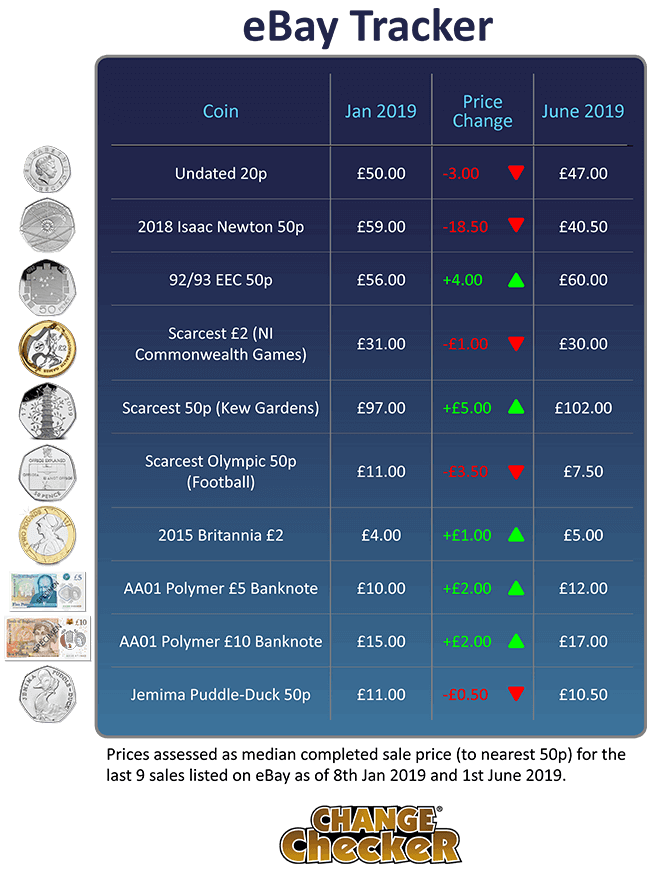
The most notable increase from the last update goes (unsurprisingly) to the Kew Gardens 50p, which has increased in price on the secondary market by £5 and is currently selling for around £102 on eBay – more than 200 times its face value!
Whilst many collectors were concerned that the 2019 Brilliant Uncirculated re-issue of this 2009 coin would make it less collectable, it seems that in fact the opposite has happened and the reinvigorated hype surrounding the UK’s rarest 50p in circulation has led to an increase in demand for the coin, meaning collectors are willing to pay more to get their hands on one.

Other increases to mention are the AA01 serial number polymer banknotes, as both the £5 and £10 notes have increased by £2 since the last update, which is a 20% increase on January’s figures for the £5 and 11% for the £10 note.
Overall there has been a decrease in value for the Top 10 coins and banknotes and this is mostly due to the 2018 Sir Isaac Newton 50p, which has dropped by 32% on January’s figures and is currently selling for £40.50.
This coin was issued as a ‘Strike Your Own Coin’ from The Royal Mint Experience in 2018 and due to the short time frame it was available for, the number of coins struck could be really low, meaning it may well be very rare.
However the mintage figures for this coin haven’t been revealed by The Royal Mint yet, so we don’t know exactly how many were struck. When the official figures are released we could well see this coin increase in value on the secondary market.
Valuation Index

My coin isn’t on the eBay Tracker
The eBay Tracker follows the movements of the Top 10 UK coins and banknotes, however if your coin doesn’t appear on the tracker you can use our 6 point guide to help determine realistic a value for your coin.
So now that you’re up to date with our latest eBay Tracker, will you be selling any of the coins in your collection or will you continue to save them? Let us know in the comments below.
How does the eBay Tracker work?
The Change Checker eBay Tracker takes the last 9 sold prices achieved on eBay and gives the median price achieved (rounded to the nearest 50p). By taking the median, rather than an average, we avoid skewing created by one or two excessive prices achieved.
Please note that the Change Checker eBay Tracker is only ever designed to be a guide as to prices achieved on eBay. Prices may vary depending on collector demand and the quality of the coin being sold. It does not provide any guarantee as to future values of coins.
If you’re interested in coin collecting, our Change Checker web app is completely free to use and allows users to:
– Find and identify the coins in their pocket
– Collect and track the coins they have
– Swap their spare coins with other Change Checkers
Sign up today at: www.changechecker.org/app

